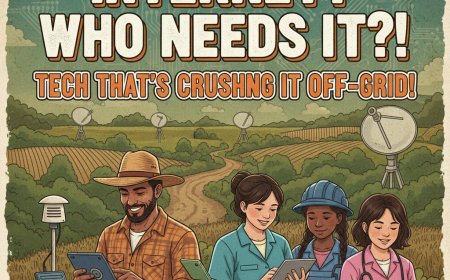The Quiet Rise of Offline Tech: How Low-Connectivity Innovations Are Changing Rural Lives
Discover how offline technology is transforming rural communities, enabling education, healthcare, and business solutions without constant internet. Explore low-connectivity innovations that are quietly reshaping lives in remote areas across the globe.

Imagine a village life in which internet access is a luxury. Streaming a video, taking an online class, or just browsing through current news isn't always a choice. That's the case for millions of rural residents worldwide. Yet technology is discovering subtle ways of narrowing this gap. Meet the offline tech world's low-connectivity innovations that are transforming education, healthcare, commerce, and daily life in the countryside.
Offline tech is not a replacement for the internet. Instead, it's how to get technology working when connectivity levels are low. From data-caching apps to equipment that synchronizes where there is a connection, these workarounds are offering individuals in areas of low connection opportunities beyond their wildest dreams.
What is Offline Tech? Understanding Low-Connectivity Innovations
Offline technology is the name for applications, apps, and systems designed to operate without a constant internet connection. Take the example of classroom apps that cache content for offline use or electronic payment systems that buffer payments until an online network is available. Low-connectivity technology has existed, but it's gaining momentum as entrepreneurs realize the untapped potential of rural economies.
The main mission of offline tech is simple: provide access to information and services regardless of internet stability. It makes technology available, hence allowing rural communities to enjoy the benefits of the digital age without being left behind.
Why Rural Communities Need Offline Tech
Rural communities are faced with several challenges that make offline tech a necessity:
Limited or sketchy internet: Many villages have sketchy coverage, and typical online use becomes maddening or even impossible.
Educational handicaps: Students in rural locations have no access to internet learning sites or materials available in cities.
Healthcare limitations: Telemedicine equipment is not necessarily available to clinics, and medical staff do not often have online access to up-to-date medical databases.
Economic potential: Rural businesses do not have online shopping malls or bank software, so it is hard for them to grow outside their local market.
Offline tech solves these problems, providing mechanisms for education, healthcare, and economic growth that do not rely on high-quality internet connections.
Most Important Offline Tech Innovations That Are Changing Life Today
A number of low-connectivity innovations are already changing the lives of rural people. Let's consider a few examples:
Offline Educational Platforms
Tools like Khan Academy Lite, Eneza Education, and offline MOOCs allow students to study lessons, quizzes, and tutorials offline. Even with intermittent connectivity, students can continue learning, complete assignments, and learn new skills independently.
Offline Healthcare Solutions
Healthcare is another sector that is also experiencing rapid change. Telemedicine solutions now allow doctors to send medical advice, diagnosis, and prescriptions offline. Patient data can be captured by health personnel in villages and relayed to central repositories once internet access is available. This enhances efficiency and treatment in formerly underserved locations.
Offline Business & Finance Tools
Small business owners and entrepreneurs benefit from offline point-of-sale devices, e-books, and mobile banking apps that do not need to be connected continuously. They facilitate inventory management, tracking sales, and even processing payments, connecting nearby businesses with wider markets in the long run.
Entertainment and Media
Even entertainment activities are heading offline. Education video, music, or news updates caching apps allow rural populations to be informed and entertained even when connectivity is low. This bridges the urban-rural gap in terms of information and culture.
How Offline Tech Empowers Communities
Offline tech not only makes life convenient, it empowers communities. Here's why:
Closing the knowledge gap: The same educational resources are accessed by students as their urban counterparts, improving literacy and capability.
Creating economic opportunities: Entrepreneurs can tap into wider markets and function better, driving entrepreneurship.
Creating stronger community networks: Offline interfaces can be utilized in disseminating local data, health warnings, and local planning, enhancing cooperation and problem-solving.
Encouraging local creativity: As technology becomes accessible and adaptable, people create new means of using it to solve day-to-day problems.
Offline tech not only empowers individual lives but also unleashes the potential of an entire community.
The Challenges of Making Offline Tech a Reality
While the benefits exist, offline tech has challenges in its own right:
Low tech literacy and awareness: Some users need to be helped to effectively use new tools.
Prices of technology and apps: Even low-cost technology can be out of reach for some communities.
Maintenance and updates: Intermittent connectivity makes it hard to ensure software remains up to date.
Infrastructure support: Government projects, NGOs, and community groups are what drive mass adoption.
Despite these challenges, organizations across the world are becoming innovative when it comes to offline solutions and maximizing impact.
The Future of Offline Tech
Offline tech has incredible potential. Hybrid solutions that meld offline functionality with periodic online syncing will become the norm. Predictive software and artificial intelligence might enable the anticipation of user needs even in the absence of real-time internet.
Rural areas can gain significantly as offline innovations continue to advance, which has the potential to transform education, healthcare, business, and the government of the world. Offline technology can be the key to ensuring the digital revolution becomes a universal phenomenon accessible to every corner of the globe.
How You Can Assist or Gain from Offline Technology
As a person, entrepreneur, or corporation, there are means of engaging in offline technology:
1. Explore offline uses for education, commerce, or healthcare to observe their effect.
2. Support NGOs and startups developing low-connectivity innovations.
3. Advocate policies on investing in offline technology for rural communities.
4. Share knowledge and resources to accelerate adoption in your community.
5. Each effort matters to propagate the scope of offline technology to those most in need.
Conclusion
Offline technology is transforming rural life quietly, enabling education, healthcare, commerce, and social interaction in areas where connectivity is sparse. It's proof that innovation isn't always about shiny gadgets or high-speed internet; it's about solving actual problems with smart, accessible solutions.
With these low-connectivity technologies growing, rural communities will have more than ever before the opportunity to learn, earn, and thrive. Tech offline may be quiet, but its message is deafening, and its potential is just beginning to be heard.
What's Your Reaction?
 Like
0
Like
0
 Dislike
0
Dislike
0
 Love
0
Love
0
 Funny
0
Funny
0
 Angry
0
Angry
0
 Sad
0
Sad
0
 Wow
0
Wow
0










































































